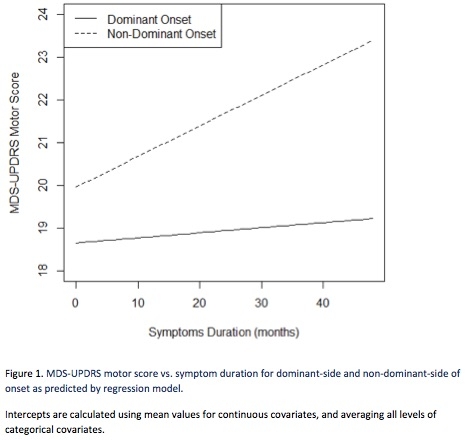Session Information
Date: Tuesday, June 21, 2016
Session Title: Parkinson's disease: Pathophysiology
Session Time: 12:30pm-2:00pm
Location: Exhibit Hall located in Hall B, Level 2
Objective: Evaluate (1) the effect of dominant-side onset (DSO) vs non-dominant-side onset (NDSO) of Parkinson’s disease (PD) on motor impairment in a large multicenter cohort and (2) test whether patient demographics or disease characteristics modulate this effect.
Background: A recent study of 118 right-handed early stage PD patients suggested that DSO presentation of PD is associated with less motor impairment compared to NDSO. This finding has not been replicated and it remains unknown whether an analogous effect is present in left-handed patients or later stage patients.
Methods: We analyzed data from the Parkinson’s Progression Markers Initiative, a 5-year multicenter longitudinal study of early stage drug-naive idiopathic PD patients. Of the 1451 total subjects in the study, 367 met inclusion criteria of having documented asymmetrical PD and handedness. A multiple regression model was used to compare the effect of DSO vs NDSO on MDS-UPDRS motor scores after controlling for handedness, age, sex, putaminal specific binding ratio on DaT imaging, H&Y stage, motor subtype, and symptom duration. Handedness, H&Y stage and symptom duration were further examined for interaction with DSO.
Results: Clinical characterisitcs are summarized in table 1. DSO was associated with a 2.63 (95% CI:1.26, 3.99, p= 0.0002) reduction in MDS-UPDRS motor score compared to NDSO. Sub-analysis of the 35 left-handed patients showed DSO was associated with a non-significant 2.30 reduction in MDS-UPDRS scores compared to NDSO (p=0.33). Table 2 and Figure 1 show an interaction between DSO and H&Y stage (p=0.043) and an interaction between DSO and symptom duration that almost reached significance (p= 0.053). DSO was associated with a reduced MPS-UPDRS motor score by 4.68 units (p= 0.0002) for H&Y II-III, but only 1.70 units (p= 0.043) for H&Y 1.
| Dominant (n=203) | Non-Dominant (n=164) | P-Value | |
| Age (years) | 65.1 +/- 9.9 | 63.1 +/- 10.2 | 0.053 |
| Sex (%Male) | 68% | 55% | 0.014 |
| Handedness (%Right) | 89.1% | 92% | 0.340 |
| Symptom Duration (months) | 23.3 +/- 22.1 | 23.1 +/- 25.8 | 0.90 |
| Hoehn & Yahr Stage | 1.4 +/- 0.5 | 1.4 +/- 0.5 | 0.75 |
| More affected putaminal SBR | 0.68 +/- 0.22 | 0.69 +/- 0.37 | 0.89 |
| MDS-UPDRS III Score | 18.4 +/- 0.55 | 21.18 +/- 0.74 | 0.003 |
| Motor Subtype (TD/PIGD/IND) | 155/33/15 | 112/29/23 | 0.09 |
| Symptom Duration (months) | Adjusted* MDS-UPDRS Effect | P-Value |
| 12 | -2.02 | 0.0081 |
| 18 | -2.38 | 0.0008 |
| 24 | -2.74 | <0.0001 |
| 36 | -3.46 | <0.0001 |

Conclusions: Our study adds support to the finding that DSO of PD is associated with slower motor progression compared with NDSO. This effect appears to persist for at least 3 years after symptom onset resulting in greater motor difference between groups with longer disease duration and higher H&Y stage. Additional studies of longer duration and with larger samples of left-handed patients will be necessary to elucidate whether this effect persists through the disease course and clarify if this effect is mediated by greater neural reserve on the brain’s dominant-side or to underlying hemispheric differences.
To cite this abstract in AMA style:
T.A. Finseth, S. Sillau, B. Berman. Parkinson’s disease onset on non-dominant side predicts greater motor disability [abstract]. Mov Disord. 2016; 31 (suppl 2). https://www.mdsabstracts.org/abstract/parkinsons-disease-onset-on-non-dominant-side-predicts-greater-motor-disability/. Accessed December 27, 2025.« Back to 2016 International Congress
MDS Abstracts - https://www.mdsabstracts.org/abstract/parkinsons-disease-onset-on-non-dominant-side-predicts-greater-motor-disability/
